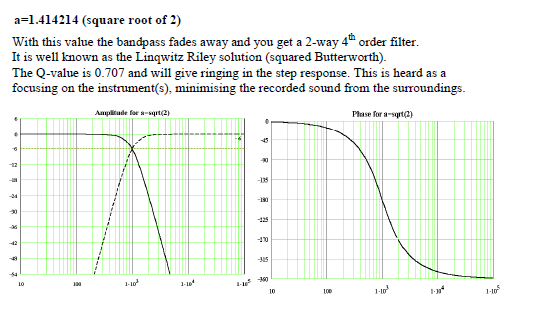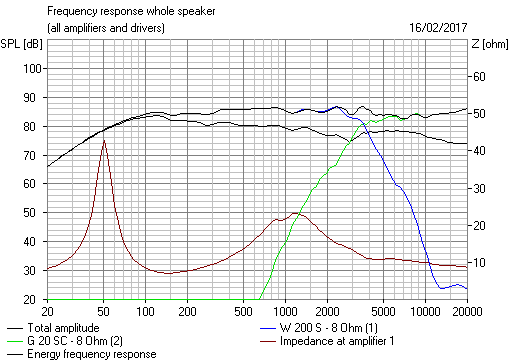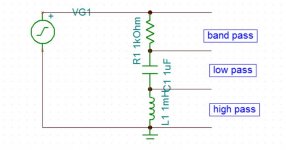Yes, I've done it often enough but it isn't normally necessary. When you consider how close you normally have to cross to breakup, etc. Sometimes there might be an issue beyond the cross that you want to take down fast. If you notch you can achieve very fast slopes at the end.
I like to say cross as steeply as you need but no steeper, and I have been happy with that. It can be useful to blend directivity patterns which may be more smooth if you don't go too steep. This is because it can be hard to control directivity near a crossover.
I like to say cross as steeply as you need but no steeper, and I have been happy with that. It can be useful to blend directivity patterns which may be more smooth if you don't go too steep. This is because it can be hard to control directivity near a crossover.
I think AllenB points it out correctly. Keeping grave distortions outside the passband (from breaking up or otherwise) low, say -40dB or less, should be a design principle. So you often end up using a steep filter on a metal cone midrange or on a tweeter that has to come in low.
When you use a low pass and high pass as crossover, the band pass gets missing to make the total sound. The higher is the order, the smaller is the band pass hence less sound loss.
Another technique is to use 8th order Bessel for low pass and subtract it from the delayed input, it yields perfect complimentary 2 way with second order high pass.
Another technique is to use 8th order Bessel for low pass and subtract it from the delayed input, it yields perfect complimentary 2 way with second order high pass.
Are you talking about power response ? At least on-axis there is nothing missing with crossover orders as low as 2nd order LR for instance.
I haven't tried subtractive-delay with orders as high as 8th order Bessel so far. I am not sure if it has much Advantage over 4th or 6th order because even very high orders of Bessel Filters are quite shallow in the cutoff area - while still offering only 2nd order rolloff in the HF branch.
Regards
Charles
I haven't tried subtractive-delay with orders as high as 8th order Bessel so far. I am not sure if it has much Advantage over 4th or 6th order because even very high orders of Bessel Filters are quite shallow in the cutoff area - while still offering only 2nd order rolloff in the HF branch.
Regards
Charles
What do you want to prove with this series resonant circuit - which is not at all representative of a crossover ? To start with: It takes no power at very low and very high frequencies which is far from what a speaker with crossover does.
If you had a load over each reactive element but no series resistor then you would indeed have a series crossover.
Regards
Charles
If you had a load over each reactive element but no series resistor then you would indeed have a series crossover.
Regards
Charles
Much wisdom given in this thread. I'd encourage anyone deeply interested in filters to download a simple simulator to a Windows PC and see where it leads.
Software | Visaton
Import a project into the projekte folder and become "As a light unto Yourself" if you follow?
2 Wege – Boxsim Projektdatenbank

Simple LR4 filter theory.

Notice the power hole at crossover. You can hear it.
Not the only way to do things, this 90 degree phase Butterworth aka BW3:

Sounds far more natural IMO. https://www.diyaudio.com/forums/multi-way/203461-restoring-monitor-audio-r300-bookshelf-speakers-4.html#post4990630
Software | Visaton
Import a project into the projekte folder and become "As a light unto Yourself" if you follow?
2 Wege – Boxsim Projektdatenbank
Simple LR4 filter theory.
Notice the power hole at crossover. You can hear it.
Not the only way to do things, this 90 degree phase Butterworth aka BW3:
Sounds far more natural IMO. https://www.diyaudio.com/forums/multi-way/203461-restoring-monitor-audio-r300-bookshelf-speakers-4.html#post4990630
These are french old documents from J. Hiraga's L'Audiophile magazine archives.
Filtres er enceinte acoustiques
Document sans titre
Réalisation des filtres passifs (J.Mahul)
Filtres er enceinte acoustiques
Document sans titre
Réalisation des filtres passifs (J.Mahul)
In car audio, I found the 48 dB/octave really satisfied me. But that was another way since it was an active crossover provided by the head unit. I’m hesitating to bring the 48 dB/octave to be used in home audio, with the passive form. Not sure if 8 of passive components used for each filter is a good idea. 16 components for lo-pass combined with hi-pass.
Doing steep filters can seem very impressive at first, but even with a bit of "digital majick bias" after a while you sometimes become aware that there can be drawbacks to using sharp filters.
Oddly enough, after A/B'ing a lot I often end up with Bessel filters in the 100-1.5khz range, Elliptic 1.2khz up, Butterworth sometimes 0-120hz. Almost every single time I end up with some slight offset on the xo, it's hardly ever "just right" with both HP and LP at the same fixed frequency. Some places 2nd order work best, 3rd order or even 4th order.
I've had some speakers with 8th order offset Bessel filters roughly centered ca 214hz xo for a while now, and it sounds fairly decent. But in general I prefer to stay below 4th order.
Love my small speakers with 1st order filters, they are special to me. Needs careful planning to work well.
Oddly enough, after A/B'ing a lot I often end up with Bessel filters in the 100-1.5khz range, Elliptic 1.2khz up, Butterworth sometimes 0-120hz. Almost every single time I end up with some slight offset on the xo, it's hardly ever "just right" with both HP and LP at the same fixed frequency. Some places 2nd order work best, 3rd order or even 4th order.
I've had some speakers with 8th order offset Bessel filters roughly centered ca 214hz xo for a while now, and it sounds fairly decent. But in general I prefer to stay below 4th order.
Love my small speakers with 1st order filters, they are special to me. Needs careful planning to work well.
I like as low an order that works, for either active or passive, for better time domain response.
Unless the active is FIR linear phase xovers.
Then, I typically use complementary 16th order, as it invariably improves polars, and achieves time domain response equal to first order.
Unless the active is FIR linear phase xovers.
Then, I typically use complementary 16th order, as it invariably improves polars, and achieves time domain response equal to first order.
I've always admired the DEQX stuff (and found their manual a very good general reference).
I've a/b'ed brickwalls vs the 16th orders I've come to use, and can't really say it ever seemed to matter. Maybe it would matter doing fine polar tuning work, but my measurement setup doesn't allow that kind of precision.
My biggest reason to sticking to 16th order is I can hold that slope/order on any xover frequency above about 200Hz.
Brickwalls, with the processor I'm using that has modestly more power than the DEQX's, begin to lose shape starting somewhere under 1000Hz.
So i just stick with 16th order LR's and know what I'm getting.
A bigger hammer still than either any DEQX or my rig, is lowly a raspPi and Jriver etc. !!
Anyway, back on topic...imho...low order rules...until it meets lin phase
I've a/b'ed brickwalls vs the 16th orders I've come to use, and can't really say it ever seemed to matter. Maybe it would matter doing fine polar tuning work, but my measurement setup doesn't allow that kind of precision.
My biggest reason to sticking to 16th order is I can hold that slope/order on any xover frequency above about 200Hz.
Brickwalls, with the processor I'm using that has modestly more power than the DEQX's, begin to lose shape starting somewhere under 1000Hz.
So i just stick with 16th order LR's and know what I'm getting.
A bigger hammer still than either any DEQX or my rig, is lowly a raspPi and Jriver etc. !!
Anyway, back on topic...imho...low order rules...until it meets lin phase
Mr. Linkwitz discussed this on his site.
Active Filters
"Crossover filters of higher order than LR4 are probably not useful, because of an increasing peak in group delay around f0."
Active Filters
"Crossover filters of higher order than LR4 are probably not useful, because of an increasing peak in group delay around f0."
Could anyone please inform the advantages and disadvantages of using higher orders above 4th order?
Yes, there is a serious disadvantage, and it is already starting to rear its ugly head by 4th order, namely peaking of group delay.
Both HP and LP analog filters (even when implemented via DSP as IIR filters) have a group delay profile that is not "flat" meaning that some frequencies come out sooner or later than others. When there is a band that has a large difference compared to others WRT group delay, you have group delay peaking.
The higher the filter order, the worse this problem is, that is the greater the difference between the delay of the GD peak and other frequencies in the passband. This is caused by the high Q parts of the filter that are commonly found in higher order Butterworth and yes even LR filters that are needed to make the sharp knee.
There have been limited experiments about the audibility of GD peaking, and when there is about a 1-2 msec GD difference between the peak and other frequencies it begins to be audible and this is why in general higher is not better when it comes to the filter order. I hedge a guess that this is why some people prefer very shallow filters like LR2 sonically.
Sure, you can use these filters. They will not sound like garbage. But at the most discerning level they will have a flaw, and if you have a very good system it might stand out and ruin what otherwise might be something excellent.
Unless you are good a filter design and can roll your own type of filter while keeping an eye on the GD peaking, the way to implement high rolloff rate aka sharp filters is using FIR DSP. Because you have the ability to set the phase response independently of the ampltidue response (which is not the case for analog style filters), you can create a filter with perfectly flat group delay everywhere and GD peaking is a non-issue.
You can read about this elsewhere, for example SL wrote about it a little bit here:
Frontiers: F - Group delay and transient response
Scroll down past the first few figures to get to the GD related part.
I use a crossover filter which is 2nd order lowpass and 3rd order highpass that does not only have very low group delay (450us for a crossover frequency of 650 Hz, 10% lower than LR2) but whose group delay drops very gradually without any peaks.
Its total group delay is that of a 2nd order allpass with a pole frequency of 1750 Hz and Q=0.4.
Regards
Charles
Its total group delay is that of a 2nd order allpass with a pole frequency of 1750 Hz and Q=0.4.
Regards
Charles
- Status
- This old topic is closed. If you want to reopen this topic, contact a moderator using the "Report Post" button.
- Home
- Loudspeakers
- Multi-Way
- Going beyond Fourth order...
